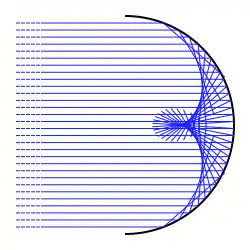Pearcey integral
In mathematics, the Pearcey integral is defined as[1]

A plot of the absolute value of the Pearcey integral as a function of its two parameters.

A photograph of a cusp caustic produced by illuminating a flat surface with a laser beam through a droplet of water.
The Pearcey integral is a class of canonical diffraction integrals, often used in wave propagation and optical diffraction problems[2] The first numerical evaluation of this integral was performed by Trevor Pearcey using the quadrature formula.[3][4]

Reflective caustic generated from a circle and parallel rays. On one side, each point is contained in three light rays; on the other side, each point is contained in one light ray.
In optics, the Pearcey integral can be used to model diffraction effects at a cusp caustic, which corresponds to the boundary between two regions of geometric optics: on one side, each point is contained in three light rays; on the other side, each point is contained in one light ray.
References
- Frank W. J. Olver, Daniel W. Lozier, Ronald F. Boisvert, Charles W. Clark, NIST Handbook of Mathematical Functions, p. 777, Cambridge, 2010
- Paris, R. B. (2011). Hadamard Expansions and Hyperasymptotic Evaluation. doi:10.1017/CBO9780511753626. ISBN 9781107002586.
- Pearcey, T. (1946). "XXXI. The structure of an electromagnetic field in the neighbourhood of a cusp of a caustic". The London, Edinburgh, and Dublin Philosophical Magazine and Journal of Science. 37 (268): 311–317. doi:10.1080/14786444608561335.
- López, José L.; Pagola, Pedro J. (2016). "Analytic formulas for the evaluation of the Pearcey integral". Mathematics of Computation. 86 (307): 2399–2407. arXiv:1601.03615. doi:10.1090/mcom/3164.
This article is issued from Wikipedia. The text is licensed under Creative Commons - Attribution - Sharealike. Additional terms may apply for the media files.